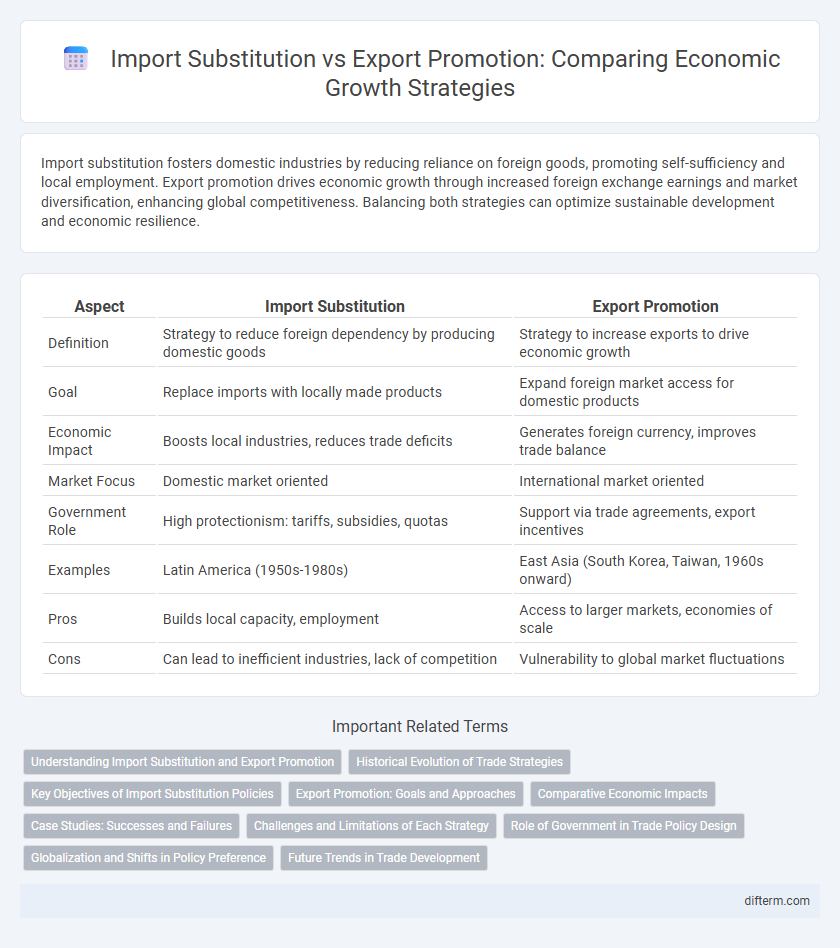Import substitution fosters domestic industries by reducing reliance on foreign goods, promoting self-sufficiency and local employment. Export promotion drives economic growth through increased foreign exchange earnings and market diversification, enhancing global competitiveness. Balancing both strategies can optimize sustainable development and economic resilience.
Table of Comparison
| Aspect | Import Substitution | Export Promotion |
|---|---|---|
| Definition | Strategy to reduce foreign dependency by producing domestic goods | Strategy to increase exports to drive economic growth |
| Goal | Replace imports with locally made products | Expand foreign market access for domestic products |
| Economic Impact | Boosts local industries, reduces trade deficits | Generates foreign currency, improves trade balance |
| Market Focus | Domestic market oriented | International market oriented |
| Government Role | High protectionism: tariffs, subsidies, quotas | Support via trade agreements, export incentives |
| Examples | Latin America (1950s-1980s) | East Asia (South Korea, Taiwan, 1960s onward) |
| Pros | Builds local capacity, employment | Access to larger markets, economies of scale |
| Cons | Can lead to inefficient industries, lack of competition | Vulnerability to global market fluctuations |
Understanding Import Substitution and Export Promotion
Import substitution focuses on reducing foreign dependency by encouraging domestic production of goods previously imported, boosting local industries and employment. Export promotion aims to enhance a country's foreign exchange earnings and economic growth by increasing exports through policies like subsidies, tax incentives, and improving trade infrastructure. Both strategies play crucial roles in shaping trade balance and industrial development within an economy.
Historical Evolution of Trade Strategies
Import substitution and export promotion represent two pivotal trade strategies that have shaped global economic policies throughout history. Import substitution, dominant from the 1930s to the 1970s, aimed to reduce dependency on foreign goods by fostering domestic industries, notably in Latin America and parts of Asia. In contrast, export promotion emerged in the late 20th century, encouraging countries like South Korea and Taiwan to integrate into the global market by boosting competitive export industries, leading to significant economic growth and development.
Key Objectives of Import Substitution Policies
Import substitution policies primarily aim to reduce dependency on foreign goods by fostering domestic industries, thereby enhancing national economic self-sufficiency. These policies seek to protect nascent industries through tariffs, quotas, and subsidies to stimulate local production and employment. Key objectives include decreasing import bills, improving trade balance, and building a diversified industrial base to support sustainable economic growth.
Export Promotion: Goals and Approaches
Export promotion aims to increase foreign exchange earnings, create jobs, and stimulate economic growth by enhancing the competitiveness of domestic industries in global markets. Key approaches include providing subsidies, improving infrastructure, implementing trade facilitation measures, and entering into favorable trade agreements to reduce barriers and expand market access. Governments often support technology adoption, quality standards, and innovation to boost export capacity and diversify export products.
Comparative Economic Impacts
Import substitution focuses on reducing foreign dependency by nurturing domestic industries, which can lead to short-term job creation but often limits market competition and innovation. Export promotion drives economic growth through global market integration, enhancing productivity and attracting foreign investment while exposing local firms to international competition. Comparative economic impacts reveal that export promotion typically yields higher long-term growth and technological advancement, whereas import substitution may shield industries temporarily but risks inefficiencies and trade imbalances.
Case Studies: Successes and Failures
Import substitution strategies in countries like Brazil and India initially boosted domestic industries but often led to inefficiencies and fiscal deficits, while export promotion policies in South Korea and Taiwan fostered rapid industrialization and sustained economic growth through global market integration. Case studies reveal that export promotion aligns better with long-term competitiveness by encouraging innovation and economies of scale, whereas import substitution may protect nascent industries but risks market complacency. Successful economic outcomes depend on adaptive policies that balance early-stage protection with gradual exposure to international competition.
Challenges and Limitations of Each Strategy
Import substitution often struggles with inefficiencies due to protectionist policies that limit competition and lead to higher production costs, while export promotion faces challenges like dependence on volatile global markets and stringent international standards. Import substitution may create domestic industries lacking innovation and scale, whereas export promotion requires significant investments in infrastructure, technology, and workforce skills to be competitive globally. Both strategies encounter fiscal constraints and policy inconsistencies that hinder sustainable economic growth.
Role of Government in Trade Policy Design
Government plays a critical role in trade policy design by shaping import substitution strategies that prioritize domestic industry protection and self-reliance, often through tariffs and quotas. In export promotion, state interventions focus on enhancing competitiveness via subsidies, infrastructure development, and favorable trade agreements to boost foreign market access. Balancing these approaches demands precise policy calibration to stimulate economic growth and diversify trade portfolios effectively.
Globalization and Shifts in Policy Preference
Import substitution strategies prioritize reducing dependence on global markets by encouraging domestic production, reflecting a protectionist stance in response to globalization. Export promotion focuses on integrating economies into global value chains through competitive export capabilities, often favored in open-market policy shifts. Recent policy preferences increasingly balance these approaches, adapting to globalization's complex demands by promoting selective import substitution alongside robust export incentives.
Future Trends in Trade Development
Import substitution policies prioritize domestic production to reduce reliance on foreign goods, fostering local industry growth but often limiting global market integration. Export promotion strategies emphasize enhancing competitiveness and market access abroad, driving innovation and economic diversification in the long term. Future trade trends indicate a balanced approach combining advanced technology adoption with sustainable practices, enabling countries to optimize both import substitution and export promotion for resilient economic development.
Import substitution vs Export promotion Infographic

 difterm.com
difterm.com